Jane Ingram Allen
Tanzania Artist-in-Residency Project
at Warm Heart Art Tanzania, Arusha, Tanzania, Africa
January 24 - February 21, 2008
This page will be a daily review of my activities and experiences during this residency project. I received a grant from the Kansas City Artists Coalition, Lighton International Artists Exchange Program for travel expenses and materials, and the host organization Warm Heart Art Tanzania (WHAT) is providing accommodations, studio space and administration for the project. During this residency I will be making new works using handmade paper created from local plant materials and helping the local artists and community people learn about papermaking using local plants. My husband Timothy S. Allen (Tim) is accompanying me on this residency, and Tim will be taking lots of photographs that will be posted with the daily accounts. I will be traveling to Tanzania from Taiwan where I have been working as an artist for the past 4 years since coming here with a Fulbright grant in January 2004.
If
you would like to comment on any of my postings or if you have any questions,
please contact me by
e
mail at info@janeingramallen.com
About Tanzania and Arusha
Tanzania is located on the East Coast of Africa and is just below Kenya. Tanzania used to be a German colony, then a British colony, and has been independent since the early 1960s. It has a stable democratic government with a president, and although there are many ethnic tribes, it seems peaceful and stable. Tanzania is known for its magnificent wildlife and many national parks. We will be staying in the city of Arusha in the northern part of Tanzania. Arusha has a relatively mild climate all year because it is at 1400 meters altitude. The city of about 270,000 people is surrounded by coffee, wheat and maize plantations. Agriculture and tourism are the major industries. Arusha is the gateway to the Serengeti National Park and also to Mt. Kilimanjaro and therefore is the safari capital of Tanzania.
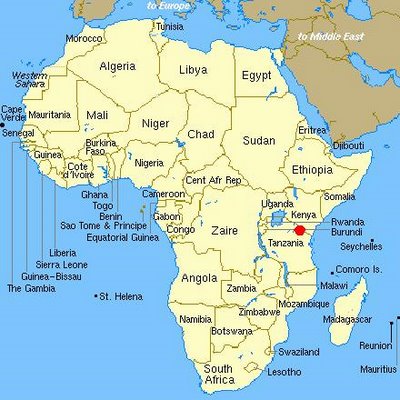
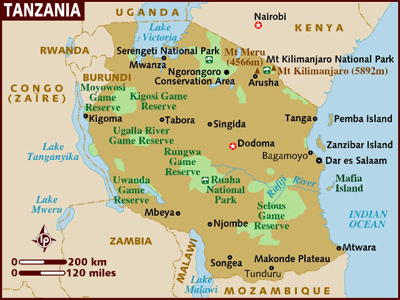
About Warm Heart Art Tanzania (WHAT) Visit the website at www.warmheartart.com
WHAT is located near the center of Arusha, and it is a small papermaking studio and art center with facilities for about 10 artists to live and work there. .Arusha Masai Cafe and an art gallery are also located there. The studio is operated by master papermaker Seppo Hallavainio, originally from Finland. Seppo has been creating his own work with handmade paper and employing local people to make handmade paper products in the studio. There is also a paper recycling center located at WHAT, and the studio is creating paper from recycled paper and from some local plants. I will try to help them locate good plants for papermaking and produce some interesting Asian style paper and develop some new products. I will be teaching workshops, presenting lectures and informal talks, and having an exhibition of my works in the gallery and on the grounds as well as making new works inspired by my first visit to Africa and the time in Tanzania.
January
24, Thursday: :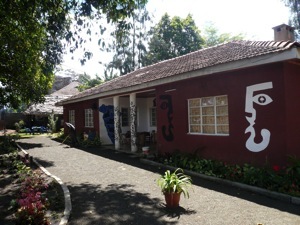 Journey
to Arusha (This photo shows one of the WHAT http://www.warmheartart.com/
buildings.)
Journey
to Arusha (This photo shows one of the WHAT http://www.warmheartart.com/
buildings.)
Tim and I leave our home in Taichung, Taiwan, to travel to Tanzania, about 12:30 PM. It will be a long journey. We take a bus from Taichung in the central part of Taiwan to the Taipei International Airport which is about a three hour ride. Then we fly from Taipei to Hong Kong on China Airlines. Then in Hong Kong we change to Ethiopian Airlines and go to Adis Ababa, Ethiopia, stopping once in Bangkok, but not changing planes. This flight is over twelve hours. Then in Adis Ababa we change to another Ethiopian Airlines plane for a short flight of about three hours to Nairobi, Kenya. There we change planes again to another Ethiopian Airlines flight to Kilimanjaro International Airport which is about 45 km from the city of Arusha, Tanzania, our final destination. The whole trip will be something like 21 hours of travel time. Seppo said he will meet us at the Kilimanjaro International Airport with a car to drive to Arusha and WHAT studio. I am sure we will be ready for a long rest ! It will be Friday, January 25, 2:10PM Tanzania time when we arrive at Kilimanjaro airport.
Friday, January 25, 2008
Arrival at Warm Heart Art Tanzania (WHAT) Studio and Arusha Masai Cafe
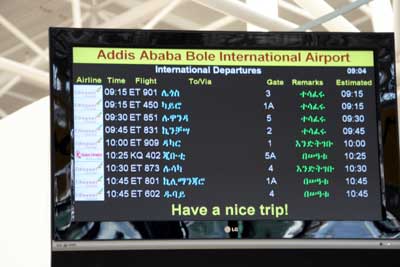
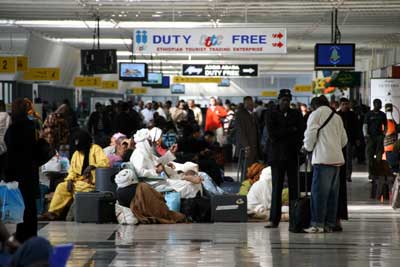 The
long journey here was long but uneventful. The whole trip took over 32
hours from our home in Taichung, Taiwan to Arusha, WHAT studio. Our longest
layover was in Addis Ababa, Ethiopia, and our flight was ET801 to Kilimanjaro
via Nairobi, Kenya propecia canada. We did have a chance to walk around in Adis Ababa
and even looked at some souvenirs in the airport shops and did lots of
people watching. We noticed a group of what looked like bedouins and watched
them go on what must have been their first ride on an escalator from the
interesting expressions on their faces. Our flight path from Nairobi,
Kenya, went very near Mt. Kilimanjaro, and the captain pointed out this
landmark on the left side of the plane. Tim took a few photos of this
famous peak in the midst of cloud cover, but you could see a few patches
of snow through the clouds. This mountain in the highest in Africa and
is visible from Arusha an from WHAT on clear days.
The
long journey here was long but uneventful. The whole trip took over 32
hours from our home in Taichung, Taiwan to Arusha, WHAT studio. Our longest
layover was in Addis Ababa, Ethiopia, and our flight was ET801 to Kilimanjaro
via Nairobi, Kenya propecia canada. We did have a chance to walk around in Adis Ababa
and even looked at some souvenirs in the airport shops and did lots of
people watching. We noticed a group of what looked like bedouins and watched
them go on what must have been their first ride on an escalator from the
interesting expressions on their faces. Our flight path from Nairobi,
Kenya, went very near Mt. Kilimanjaro, and the captain pointed out this
landmark on the left side of the plane. Tim took a few photos of this
famous peak in the midst of cloud cover, but you could see a few patches
of snow through the clouds. This mountain in the highest in Africa and
is visible from Arusha an from WHAT on clear days.
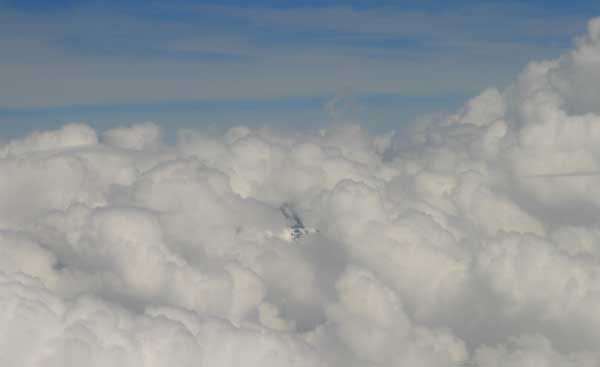
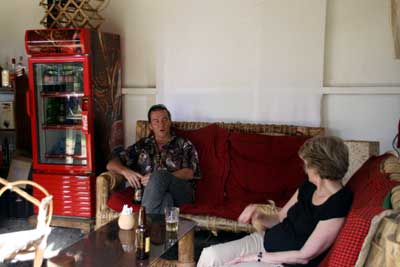 Our
host, Seppo Hallavainio, met us at Kilimanjaro airport in his 4 wheel
drive vehicle, and took us to his WHAT studio at Arusha Masai Cafe. We
got introduced to his family and the staff and several artists who also
came by. The studio is in a beautiful garden surroundings with lots of
interesting trees and plants to use for papermaking. Tim and I are staying
in the main building next the to art gallery in a suite of two rooms with
bath. We unpacked, looked around, had dinner (vegetable pizza cooked in
a wood-fired oven) and then soon after went to bed. It was great to stretch
out in a real bed, and we figured out how to climb in under a mosquito
net. We are taking some medicine for malaria prevention, but mosquito
nets are common and do help to keep the bugs away at night.
Our
host, Seppo Hallavainio, met us at Kilimanjaro airport in his 4 wheel
drive vehicle, and took us to his WHAT studio at Arusha Masai Cafe. We
got introduced to his family and the staff and several artists who also
came by. The studio is in a beautiful garden surroundings with lots of
interesting trees and plants to use for papermaking. Tim and I are staying
in the main building next the to art gallery in a suite of two rooms with
bath. We unpacked, looked around, had dinner (vegetable pizza cooked in
a wood-fired oven) and then soon after went to bed. It was great to stretch
out in a real bed, and we figured out how to climb in under a mosquito
net. We are taking some medicine for malaria prevention, but mosquito
nets are common and do help to keep the bugs away at night.
Saturday, January 26
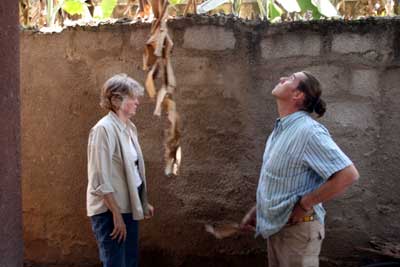
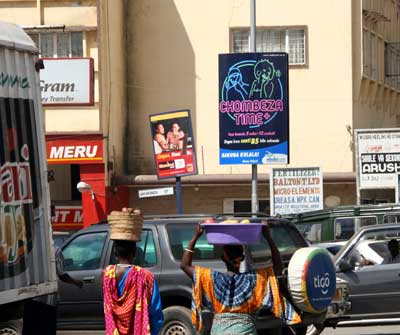 Today
we had a chance to walk around the grounds and get acquainted with everyone
as well as check out the plants growing in the garden around the workshop
and the cafe. One of the things I noticed is that there are many banana
trees and this variety seems to be the common eating banana. I think it
might make paper as other banana species do work well. This photo shows
Seppo and me looking at one of the banana trees hanging over the fence.
Seppo also showed me some of the papers he has been making and we talked
about the many fibers we could use and the workshop class in papermaking
we are planning for next weekend. We also drove around the town of Arusha,
and the streets are filled with people and many vehicles. This photo Tim
took of a street scene in Arusha
Today
we had a chance to walk around the grounds and get acquainted with everyone
as well as check out the plants growing in the garden around the workshop
and the cafe. One of the things I noticed is that there are many banana
trees and this variety seems to be the common eating banana. I think it
might make paper as other banana species do work well. This photo shows
Seppo and me looking at one of the banana trees hanging over the fence.
Seppo also showed me some of the papers he has been making and we talked
about the many fibers we could use and the workshop class in papermaking
we are planning for next weekend. We also drove around the town of Arusha,
and the streets are filled with people and many vehicles. This photo Tim
took of a street scene in Arusha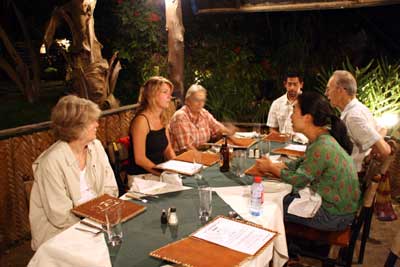
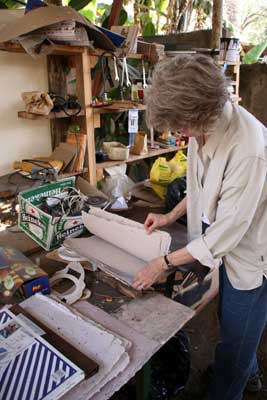 shows
women carrying things on their heads which we found fascinating. The women
look so elegant balancing large loads on their heads.
shows
women carrying things on their heads which we found fascinating. The women
look so elegant balancing large loads on their heads.
We finished the day by having dinner with Michael, a young man from California who is staying at Arusha Masai Cafe as well. We went to a restaurant called the Oasis and were joined by a group of volunteers who are working with Michael at schools in the Arusha area. This photo shows us eating at the outdoor seating area of the Oasis. It was a very interesting restaurant, and the drive there over very narrow bumpy unpaved roads was also an experience.
Sunday, January 27
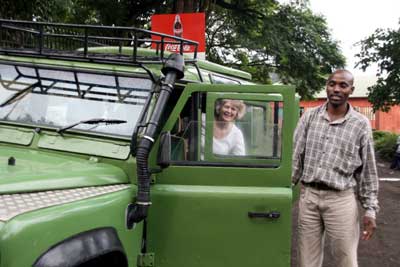
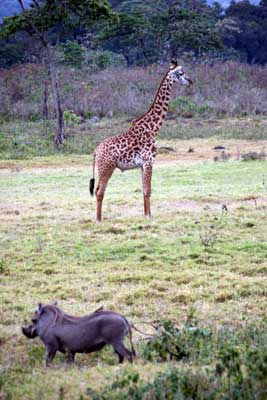 This
day we went on our first safari! Seppo had arranged for us to go on a
one-day safari to Arusha National Park . We went in a Land Rover with
John, the brother of Seppo's wife Julia, as our driver. This photo shows
me with John as we are about to set out on the safari. There are no large
predators in Arushas National Park but we saw lots of giraffes and zebras,
wart hogs and water buffalos, baboons and monkey and also some interesting
birds. The most exciting thing was being so close to live animals and
this is one of the only parks in Tanzania where people are allowed to
go on a walking tour. You are always accompanied by an armed guard on
the walk .
This
day we went on our first safari! Seppo had arranged for us to go on a
one-day safari to Arusha National Park . We went in a Land Rover with
John, the brother of Seppo's wife Julia, as our driver. This photo shows
me with John as we are about to set out on the safari. There are no large
predators in Arushas National Park but we saw lots of giraffes and zebras,
wart hogs and water buffalos, baboons and monkey and also some interesting
birds. The most exciting thing was being so close to live animals and
this is one of the only parks in Tanzania where people are allowed to
go on a walking tour. You are always accompanied by an armed guard on
the walk .
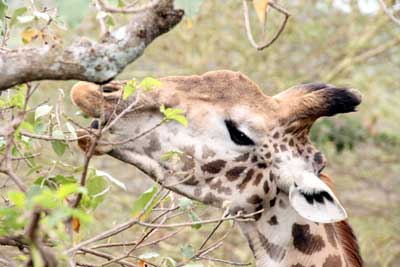
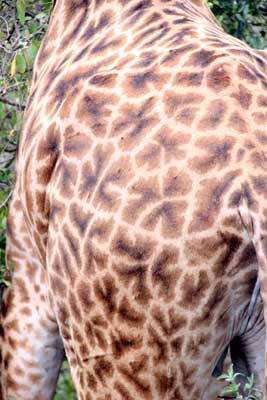 We
got really close to a pair of giraffes who were near the road when we
were riding around the park after the walking tour. This photo shows the
wonderful pattern on the giraffes. We also enjoyed seeing the giraffes
eating. They eat acacia leaves and this type of acacia has long wicked
looking thorns, but somehow the giraffes manage to eat the leaves. This
was an exciting day and really made us aware we were in Africa.
We
got really close to a pair of giraffes who were near the road when we
were riding around the park after the walking tour. This photo shows the
wonderful pattern on the giraffes. We also enjoyed seeing the giraffes
eating. They eat acacia leaves and this type of acacia has long wicked
looking thorns, but somehow the giraffes manage to eat the leaves. This
was an exciting day and really made us aware we were in Africa.
Monday, January 28
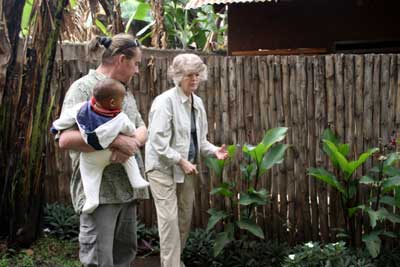
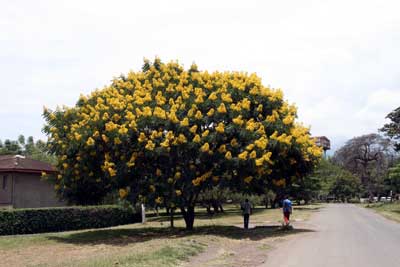 This
day we began to plan what plants we could use for papermaking and this
photo shows Seppo and me looking at some Canna lily leaves in the garden
as a possibility. Seppo is holding his 8-month-old son Roni O. We also
went shopping around town to buy some supplies for papermaking, We passed
many beautiful trees covered with yellow blossoms. This is also a species
of acacia, and since the caretakers had just cut many branches of the
trees along the roadside, we decided to collect some of them to use the
bark for papermaking. This photo shows one of the trees.
This
day we began to plan what plants we could use for papermaking and this
photo shows Seppo and me looking at some Canna lily leaves in the garden
as a possibility. Seppo is holding his 8-month-old son Roni O. We also
went shopping around town to buy some supplies for papermaking, We passed
many beautiful trees covered with yellow blossoms. This is also a species
of acacia, and since the caretakers had just cut many branches of the
trees along the roadside, we decided to collect some of them to use the
bark for papermaking. This photo shows one of the trees.
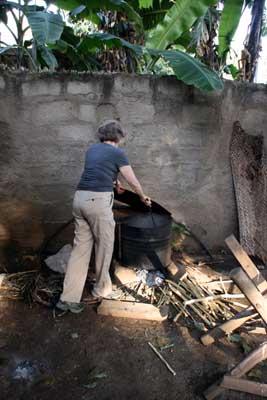
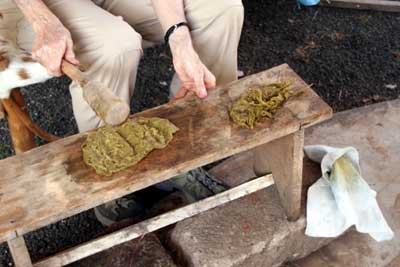 We
began cooking some of the mulberry bark that Seppo had gathered the week
before. The cooking here is done outdoors over a wood-burning fire with
an old oil drum used as the cooking pot. This photo shows the pot of mulberry
bark fibers boiling. After cooking the mulberry all morning I spent part
of the afternoon beating the fiber to a pulp by hand using a wooden hammer.
This photo shows me beating some of the mulberry fibers. This tree is
common in the Arusha area and also one I have used in Japan and Taiwan,
and it always makes good quality paper. I made my first sheets of paper
from the mulberry fibers in Tanzania.
We
began cooking some of the mulberry bark that Seppo had gathered the week
before. The cooking here is done outdoors over a wood-burning fire with
an old oil drum used as the cooking pot. This photo shows the pot of mulberry
bark fibers boiling. After cooking the mulberry all morning I spent part
of the afternoon beating the fiber to a pulp by hand using a wooden hammer.
This photo shows me beating some of the mulberry fibers. This tree is
common in the Arusha area and also one I have used in Japan and Taiwan,
and it always makes good quality paper. I made my first sheets of paper
from the mulberry fibers in Tanzania.
Tuesday, January 29
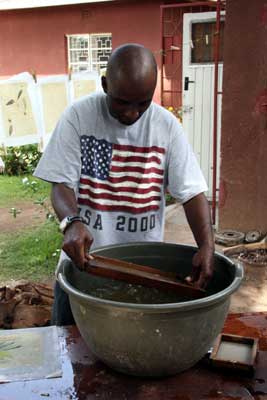
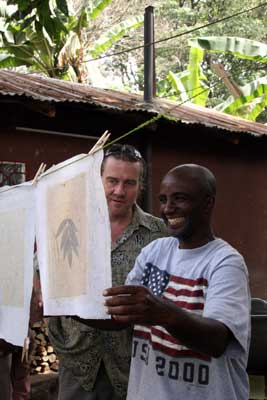
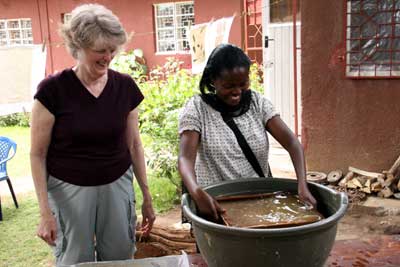 I
continued making paper, and some of the local people joined in to learn
the process. This photo shows Kambi, a painter who is having an exhibition
in the gallery at Arusha Masai Cafe, making his first sheet of paper.
Seppo and Kambi are shown here looking at the paper he made using mulberry
bark fibers with some acacia leaves added in as decorative elements. Kambi's
girlfriend was also persuaded to try her hand at making some paper. This
photo shows me teaching her how to make paper.
I
continued making paper, and some of the local people joined in to learn
the process. This photo shows Kambi, a painter who is having an exhibition
in the gallery at Arusha Masai Cafe, making his first sheet of paper.
Seppo and Kambi are shown here looking at the paper he made using mulberry
bark fibers with some acacia leaves added in as decorative elements. Kambi's
girlfriend was also persuaded to try her hand at making some paper. This
photo shows me teaching her how to make paper.
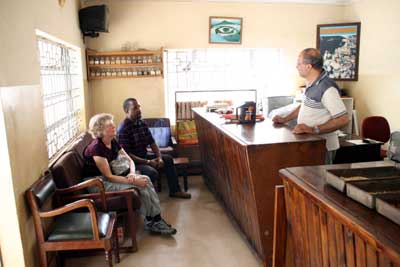
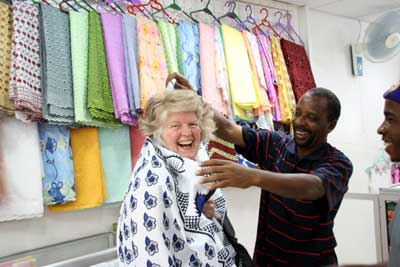 During
the afternoon Tim and I went around town with another artist friend Pelle,
who lives in Arusha and that I had met through e mail before we came.
Pelle organizes art camps for international artists and one of the artists
I know from Taiwan has participated in his art camp several years ago.
Pelle took us to visit the owner of a former papermaking factory in Arusha,
and this photo shows us visiting with him in the factory office. Now the
family business is in dried grains and seeds rather than papermaking which
he said did not make enough money. Pelle also took us around to buy some
tubs for papermaking vats, and we found that the only plastic tubs available
were round ones. Pelle also took us shopping and we bought some of the
colorful printed cotton fabric. This photo shows them showing me how the
fabric should be draped around for the traditional African dress. We also
went through the local market area, and it was filled with people and
many interesting things to buy, from vegetables and fruits to cooking
pots. We looked at some large metal pots that we thought might be good
for cooking the paper fibers, but decided not to buy one since the pots
seemed too shallow. This market was fascinating, but we were constantly
being accosted to buy something since we were Westerners. It is definitely
a country where white people stand out and people are sometimes too insistent
and made us feel uncomfortable.
During
the afternoon Tim and I went around town with another artist friend Pelle,
who lives in Arusha and that I had met through e mail before we came.
Pelle organizes art camps for international artists and one of the artists
I know from Taiwan has participated in his art camp several years ago.
Pelle took us to visit the owner of a former papermaking factory in Arusha,
and this photo shows us visiting with him in the factory office. Now the
family business is in dried grains and seeds rather than papermaking which
he said did not make enough money. Pelle also took us around to buy some
tubs for papermaking vats, and we found that the only plastic tubs available
were round ones. Pelle also took us shopping and we bought some of the
colorful printed cotton fabric. This photo shows them showing me how the
fabric should be draped around for the traditional African dress. We also
went through the local market area, and it was filled with people and
many interesting things to buy, from vegetables and fruits to cooking
pots. We looked at some large metal pots that we thought might be good
for cooking the paper fibers, but decided not to buy one since the pots
seemed too shallow. This market was fascinating, but we were constantly
being accosted to buy something since we were Westerners. It is definitely
a country where white people stand out and people are sometimes too insistent
and made us feel uncomfortable.
Wednesday, January 30
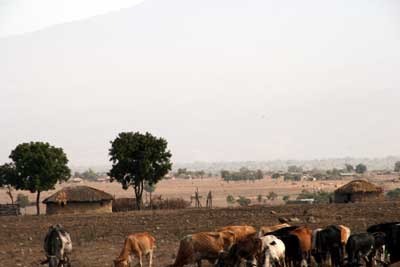
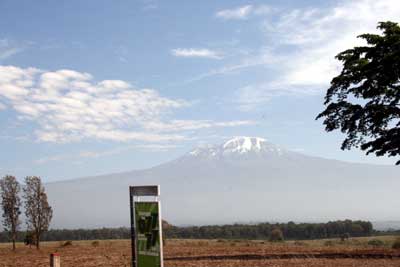 Today
we made a trip with Seppo to the nearby town of Moshi where he had lived
before moving to Arusha in August 2007. Moshi is about 75 km from Arusha,
and we traveled over paved roads through some very hot and dusty plains.
The roadside views were fascinating, and this photo shows some of the
cattle and huts we saw along the way. While driving to Moshi we were also
lucky to get some great views of Mt. Kilimanjaro with snow on top that
you can see in this photo. We were told that usually the mountain is covered
by clouds.
Today
we made a trip with Seppo to the nearby town of Moshi where he had lived
before moving to Arusha in August 2007. Moshi is about 75 km from Arusha,
and we traveled over paved roads through some very hot and dusty plains.
The roadside views were fascinating, and this photo shows some of the
cattle and huts we saw along the way. While driving to Moshi we were also
lucky to get some great views of Mt. Kilimanjaro with snow on top that
you can see in this photo. We were told that usually the mountain is covered
by clouds.
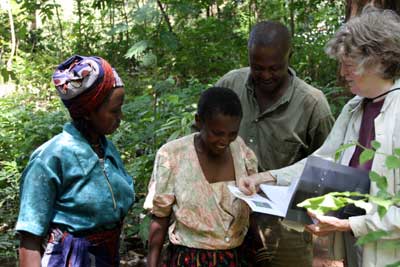
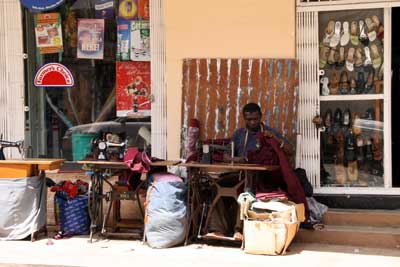 In
Moshi we visited the Kiviwama Indigenous Trees Nursery, We were introduced
to the head gardener there who has gotten very interested in papermaking
since knowing Seppo. Seppo had given him a copy of my "Made in Taiwan"
book, and he is beginning to try out many of the plants in his garden
for papermaking. The gardener gave us a tour of his tree nursery. This
photo shows me showing some samples of handmade paper to members of the
staff at the tree nursery. This nursery is in a beautiful area and has
many tall trees as well as a natural spring making it much cooler here
than in the town part of Moshi. We also did a little shopping with Seppo
in Moshi and this photo shows one of the main streets with many people
manning sewing machines on the sidewalk sewing clothing for people.
In
Moshi we visited the Kiviwama Indigenous Trees Nursery, We were introduced
to the head gardener there who has gotten very interested in papermaking
since knowing Seppo. Seppo had given him a copy of my "Made in Taiwan"
book, and he is beginning to try out many of the plants in his garden
for papermaking. The gardener gave us a tour of his tree nursery. This
photo shows me showing some samples of handmade paper to members of the
staff at the tree nursery. This nursery is in a beautiful area and has
many tall trees as well as a natural spring making it much cooler here
than in the town part of Moshi. We also did a little shopping with Seppo
in Moshi and this photo shows one of the main streets with many people
manning sewing machines on the sidewalk sewing clothing for people.
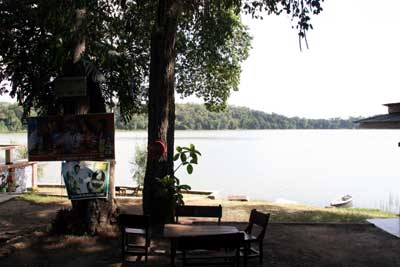
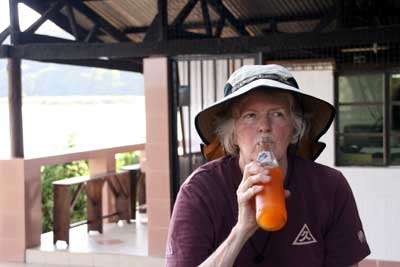 On
the way back to Arusha, Seppo took us by to see a beautiful deep crater
lake where we stopped to have something to drink . This photo shows me
enjoying a Fanta orange soda while overlooking the lake.
On
the way back to Arusha, Seppo took us by to see a beautiful deep crater
lake where we stopped to have something to drink . This photo shows me
enjoying a Fanta orange soda while overlooking the lake.
Friday, February 1
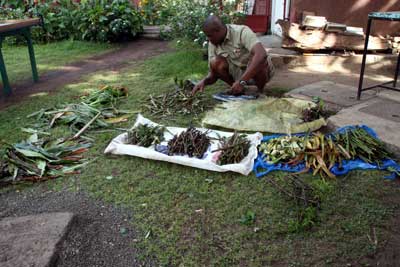
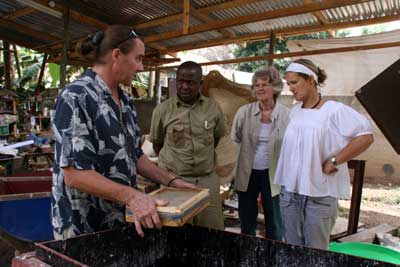 This
day was the first day of our 2-day workshop in papermaking at Warm Heart
Art Tanzania. Both Seppo and I acted as teachers and invited local people
to learn the while process of papermaking from local plants. One of the
workshop participants was Samwell manager of the native trees nursery
in nearby Moshi. He brought many bundles of plants that we could try to
make paper from. This photo shows Samwell laying out the plants and labeling
them with their scientific names. Seppo
taught the workshop participants how to make paper with the Western one-dip
method using mould and deckles that he had made for the workshop. This
photo shows him demonstrating papermaking for the group.
This
day was the first day of our 2-day workshop in papermaking at Warm Heart
Art Tanzania. Both Seppo and I acted as teachers and invited local people
to learn the while process of papermaking from local plants. One of the
workshop participants was Samwell manager of the native trees nursery
in nearby Moshi. He brought many bundles of plants that we could try to
make paper from. This photo shows Samwell laying out the plants and labeling
them with their scientific names. Seppo
taught the workshop participants how to make paper with the Western one-dip
method using mould and deckles that he had made for the workshop. This
photo shows him demonstrating papermaking for the group.
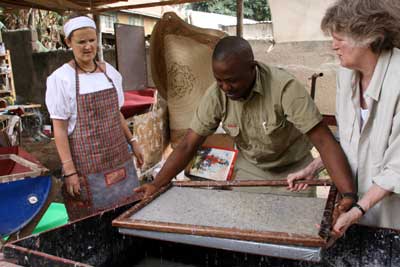
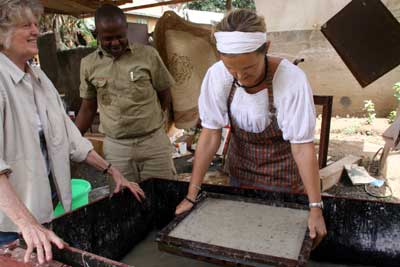 The
other photos show some of the participants making their first sheets of
paper. Later Samwell tried one of the large paper moulds which is very
difficult to manage since it is very heavy.In
the afternoon I taught the group how to form paper sheets using the Asian
method with multiple dips into the vat and using formation aid. We cooked
and beat some banana leaf, mulberry bark, sugar can leaves and will continue
tomorrow with other plants.
The
other photos show some of the participants making their first sheets of
paper. Later Samwell tried one of the large paper moulds which is very
difficult to manage since it is very heavy.In
the afternoon I taught the group how to form paper sheets using the Asian
method with multiple dips into the vat and using formation aid. We cooked
and beat some banana leaf, mulberry bark, sugar can leaves and will continue
tomorrow with other plants.
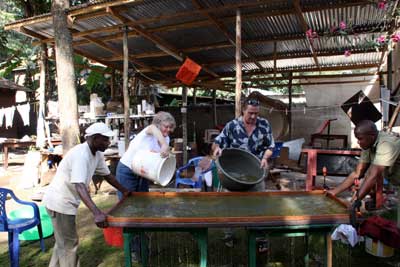 We
ended the day by making a very large sheet of paper using the pouring
method on a large screen Seppo made the day before. This was quite an
experience and we hope the paper turns out well when it dries on the screen.
This photo shows Seppo and I pouring the pulp on to the large screen while
two other participants try to move the pulp around on the screen to spread
it evenly.
We
ended the day by making a very large sheet of paper using the pouring
method on a large screen Seppo made the day before. This was quite an
experience and we hope the paper turns out well when it dries on the screen.
This photo shows Seppo and I pouring the pulp on to the large screen while
two other participants try to move the pulp around on the screen to spread
it evenly.
Saturday, February 2
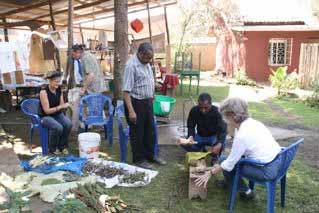
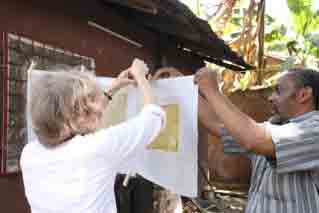 This was the second day of our papermaking workshop in Arusha. We continued cooking the local plants, and today we used pineapple leaf fibers and also mixed together the bark from three different ficus (fig) species since we did not have enough of each one. Both of these made interesting paper and we especially liked the rich brown color of the ficus bark paper. The pineapple fiber was very fine and required adapting the screen with an extra covering of cotton fabric. Another person joined the workshop today. This photo shows the workshop group in the outdoor studio space. The other photo shows Joseph hanging up one of his handmade papers to dry.
This was the second day of our papermaking workshop in Arusha. We continued cooking the local plants, and today we used pineapple leaf fibers and also mixed together the bark from three different ficus (fig) species since we did not have enough of each one. Both of these made interesting paper and we especially liked the rich brown color of the ficus bark paper. The pineapple fiber was very fine and required adapting the screen with an extra covering of cotton fabric. Another person joined the workshop today. This photo shows the workshop group in the outdoor studio space. The other photo shows Joseph hanging up one of his handmade papers to dry.
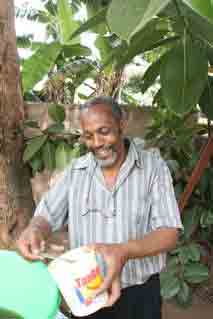
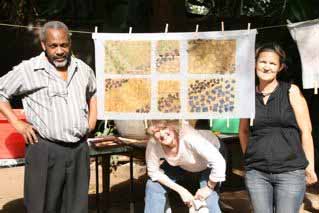 We are using the chemical powdered formation aid that I brought with me, and Joseph had never seen anything like this slimy liquid. This photo shows him adding some formation aid to the tub of pulp. I also explained that it might be easy to find okra in the local market and use this for formation aid. I showed the workshop group how to use stencils to create designs with the different natural colors of the pulp. We also made a larger work all together using strings and threads to join together multiple sheets of handmade paper. The group decided to make an image of the Tanzania flag that is in diagonal stripes of gold, green, blue and black. I learned that gold represents the sun, green the land, blue the ocean and black the people of Tanzania. This photo shows us posing with the finished flag piece hanging on the line to dry.
We are using the chemical powdered formation aid that I brought with me, and Joseph had never seen anything like this slimy liquid. This photo shows him adding some formation aid to the tub of pulp. I also explained that it might be easy to find okra in the local market and use this for formation aid. I showed the workshop group how to use stencils to create designs with the different natural colors of the pulp. We also made a larger work all together using strings and threads to join together multiple sheets of handmade paper. The group decided to make an image of the Tanzania flag that is in diagonal stripes of gold, green, blue and black. I learned that gold represents the sun, green the land, blue the ocean and black the people of Tanzania. This photo shows us posing with the finished flag piece hanging on the line to dry.
Sunday, February 3
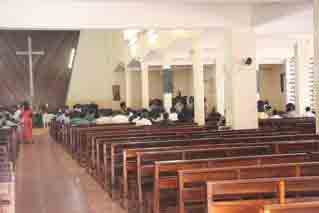 Sundays here are a day of rest and the cafe and gallery are closed to the public. I did work in the studio a little bit early this morning and took off the Tanzania flag piece after it had dried on the interfacing fabric. This photo shows the work being removed from the fabric. Maybe I will add some paint or collage to this piece and finish it up to display in the gallery next week.
Sundays here are a day of rest and the cafe and gallery are closed to the public. I did work in the studio a little bit early this morning and took off the Tanzania flag piece after it had dried on the interfacing fabric. This photo shows the work being removed from the fabric. Maybe I will add some paint or collage to this piece and finish it up to display in the gallery next week.
This was a special day for Roni O, the 8-month old son of Seppo and Julieth, our hosts at Warm Heart Art Tanzania. Ronnie was being baptized today at the church, so we were invited to go to church with many family members and friends.
This
was quite an interesting experience and we were happy to  share
this special day with the family. The best thing about the church service
share
this special day with the family. The best thing about the church service
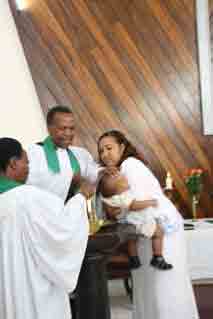 for
us was the choir singing and seeing several babies get baptized by the
minister sprinkling water on their heads. Tim was asked to photograph
everything. This photo shows the inside of the church, and this one shows
Roni O getting baptized. Another photo shows the whole family group posing
on the church steps after the service. After church we all went out to
eat at a local Indian restaurant and had some delicious Indian food and
continued to celebrate the day .
for
us was the choir singing and seeing several babies get baptized by the
minister sprinkling water on their heads. Tim was asked to photograph
everything. This photo shows the inside of the church, and this one shows
Roni O getting baptized. Another photo shows the whole family group posing
on the church steps after the service. After church we all went out to
eat at a local Indian restaurant and had some delicious Indian food and
continued to celebrate the day .
Seppo has a sauna that he heats with firewood at his place so he finished the day with his sauna. It is way too hot for me but Finns like the sauna even if they are in Africa! I took a nap in the afternoon and tried to catch up on e mail after I woke up. Our computer is still having problems, but luckily we can use Seppo's computer to keep updating these postings and do email. We are having some problems using a different system so please wait for these photos hopefully by tomorrow. 
Monday, February 4, 2008
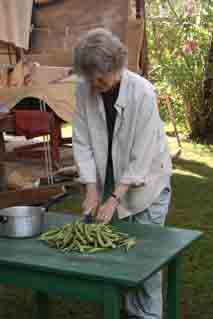
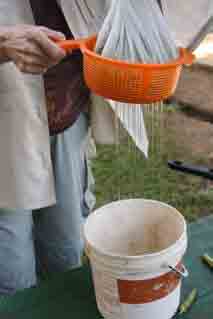 Since
we had been using the chemical powder formation aid I brought with me
from Taiwan, today I decided to try some local source for this handmade
paper additive that is used for making Japanese style paper. Okra is very
plentiful here in Tanzania, so we used some okra from the local market.
This photos shows me chopping up the okra pods. I then boiled them in
a small amount of water for about 15 minutes. After cooling I squeezed
the cooked okra through a mesh bag as you can see in this photo. This
small amount of pkra produced, quite a bit of slimy liquid to use as formation
aid. Okra makes goof formation aid, but it does start to smell bad in
a few days unless it is refrigerated. We were cooking dracaena leaves
and the bark of a tree called ceibu for most of the day. I plan to try
these for paper tomorrow. I am continuing to make paper with local plants
and making samples of each plant and producing sheets to use for a Tanzania
site map.
Since
we had been using the chemical powder formation aid I brought with me
from Taiwan, today I decided to try some local source for this handmade
paper additive that is used for making Japanese style paper. Okra is very
plentiful here in Tanzania, so we used some okra from the local market.
This photos shows me chopping up the okra pods. I then boiled them in
a small amount of water for about 15 minutes. After cooling I squeezed
the cooked okra through a mesh bag as you can see in this photo. This
small amount of pkra produced, quite a bit of slimy liquid to use as formation
aid. Okra makes goof formation aid, but it does start to smell bad in
a few days unless it is refrigerated. We were cooking dracaena leaves
and the bark of a tree called ceibu for most of the day. I plan to try
these for paper tomorrow. I am continuing to make paper with local plants
and making samples of each plant and producing sheets to use for a Tanzania
site map.
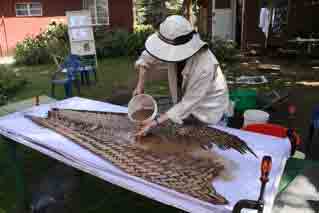
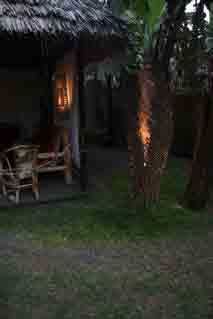 Today
Seppo and I decided to make some large lanterns to use in the garden of
the cafe. He had some local hand woven palm leaf screens, and one had
been slightly damaged leaving a few holes. I decided it would be nice
to open up the space even more and then pour paper pulp over this palm
screen. This photo shows me pouring the mixed paper pulp on the palm screen.
We left it to dry in the sun. This made an interesting and very strong
structure that we decided to use as a lantern. Seppo found some wooden
poles to go into the ground and I sewed these to the back of the piece.
Seppo then wired up a spotlight to put inside. This photo shows the lighted
lantern in the garden at the cafe. Seppo plans to make several of these
to put throughout the garden.
Today
Seppo and I decided to make some large lanterns to use in the garden of
the cafe. He had some local hand woven palm leaf screens, and one had
been slightly damaged leaving a few holes. I decided it would be nice
to open up the space even more and then pour paper pulp over this palm
screen. This photo shows me pouring the mixed paper pulp on the palm screen.
We left it to dry in the sun. This made an interesting and very strong
structure that we decided to use as a lantern. Seppo found some wooden
poles to go into the ground and I sewed these to the back of the piece.
Seppo then wired up a spotlight to put inside. This photo shows the lighted
lantern in the garden at the cafe. Seppo plans to make several of these
to put throughout the garden.
Tuesday, February 5, 2008
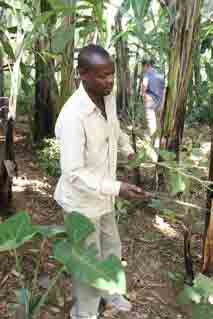
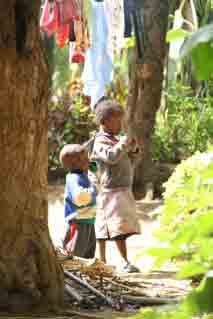 We started the day off by going to gather more plants for papermaking. We traveled a few kilometers outside Arusha city to the home of a young man named Michael. We gathered some more white mulberry branches to make paper from the bark of this tree. Mulberry seems to be growing wild amid all the banana trees in this small village. This photo shows Michael cutting some of the mulberry branches. At this village we also met some really cute kids as you can see in this photo. This village we were told has typical houses and the lifestyle is based on farming. We saw many bananas, tomatoes, corn, spinach, cabbage and I am sure other crops growing there. We also gathered some banana leaves and stems for papermaking.
We started the day off by going to gather more plants for papermaking. We traveled a few kilometers outside Arusha city to the home of a young man named Michael. We gathered some more white mulberry branches to make paper from the bark of this tree. Mulberry seems to be growing wild amid all the banana trees in this small village. This photo shows Michael cutting some of the mulberry branches. At this village we also met some really cute kids as you can see in this photo. This village we were told has typical houses and the lifestyle is based on farming. We saw many bananas, tomatoes, corn, spinach, cabbage and I am sure other crops growing there. We also gathered some banana leaves and stems for papermaking.
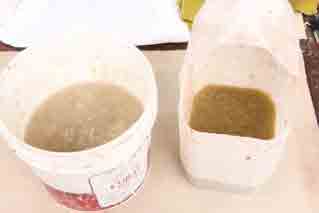
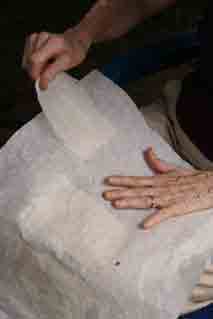 Later in the afternoon I made some paper with the white mulberry bark that we have been bleaching in the sun for about 5 days. We took a small bit of the fiber out of the last batch we made and put it in a shallow pan of water with a little lemon juice added and then set it in the sun to see how much lighter it would turn. It really worked as you can see in this photo of the original unbleached mulberry in one container and the whiter sun-bleached in the other container. This photo shows the making of the paper with the sun-bleached mulberry pulp.
Later in the afternoon I made some paper with the white mulberry bark that we have been bleaching in the sun for about 5 days. We took a small bit of the fiber out of the last batch we made and put it in a shallow pan of water with a little lemon juice added and then set it in the sun to see how much lighter it would turn. It really worked as you can see in this photo of the original unbleached mulberry in one container and the whiter sun-bleached in the other container. This photo shows the making of the paper with the sun-bleached mulberry pulp.
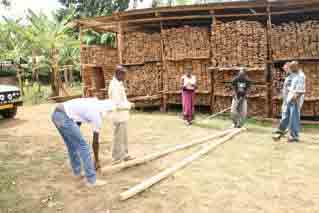
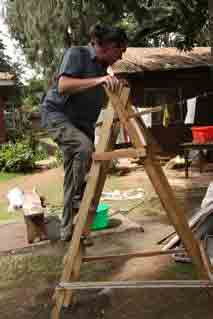 On
the way back from picking plants, we stopped at a local lumber yard and
bought some wood to make a ladder for the WHAT gallery. This is a photo
of us looking at the wood to buy at a lumber store alongside the main
road to Arusha. It seems that aluminum ladders are very expensive, and
Seppo was able to make a very sturdy wooden one. This photo shows him
trying out the new ladder he built with very basic tools and rough cut
wood. We used it later in the afternoon to start hanging my ¨Made
In Taiwan¨ works in the gallery
On
the way back from picking plants, we stopped at a local lumber yard and
bought some wood to make a ladder for the WHAT gallery. This is a photo
of us looking at the wood to buy at a lumber store alongside the main
road to Arusha. It seems that aluminum ladders are very expensive, and
Seppo was able to make a very sturdy wooden one. This photo shows him
trying out the new ladder he built with very basic tools and rough cut
wood. We used it later in the afternoon to start hanging my ¨Made
In Taiwan¨ works in the gallery
Wednesday, February 6, 2008
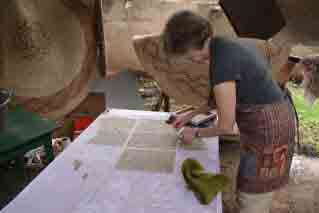
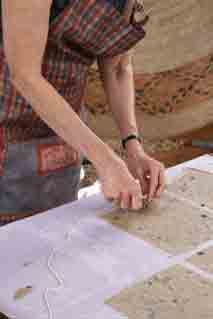 Today
I started to make a Tanzania site map using paper pulp and other materials
found here. I used a mixed pulp that contained some cotton, some African
mulberry, some dracaena and some ceibu bark fibers. I formed A-4 size
sheets on the mould and then couched them on to some white cotton fabric.
I tried to make the shape of Tanzania which is somewhat square, and so
I could not make the map very big on the rectangular table I was using.
This photo shows the beginning of the piece. I joined the pieces of paper
with thread and sisal fibers as well as some torn strips of white cotton
fabric. I also added leaves and flowers from the area. Then I couched
another thin layer of paper on top of all the sheets sandwiching the things
added between the layers. The second photo shows this work continuing.
When it all dries I will remove this from the large white sheet and have
one joined map piece that can then be painted and embellished further
working on both sides. Drying was a little difficult this day because
it has been rainy and cloudy most of the afternoon. Fortunately I moved
the piece under cover before the rains came.
Today
I started to make a Tanzania site map using paper pulp and other materials
found here. I used a mixed pulp that contained some cotton, some African
mulberry, some dracaena and some ceibu bark fibers. I formed A-4 size
sheets on the mould and then couched them on to some white cotton fabric.
I tried to make the shape of Tanzania which is somewhat square, and so
I could not make the map very big on the rectangular table I was using.
This photo shows the beginning of the piece. I joined the pieces of paper
with thread and sisal fibers as well as some torn strips of white cotton
fabric. I also added leaves and flowers from the area. Then I couched
another thin layer of paper on top of all the sheets sandwiching the things
added between the layers. The second photo shows this work continuing.
When it all dries I will remove this from the large white sheet and have
one joined map piece that can then be painted and embellished further
working on both sides. Drying was a little difficult this day because
it has been rainy and cloudy most of the afternoon. Fortunately I moved
the piece under cover before the rains came.
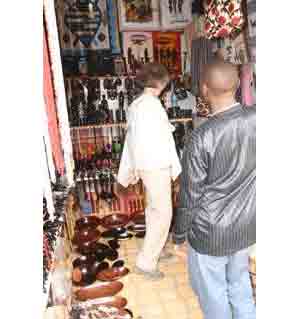
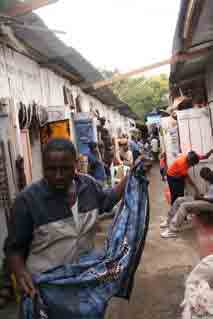 In the afternoon while my site map was drying we went to the Arusha Masai market where you can buy all sorts of hand crafts made by local people. As you can see in this photo there are many small stalls full of wood carvings, various fabric goods, baskets, bead work and things made from coca cola bottle caps, and etc. This photo shows me looking at some batik fabric. I was too tired to buy anything on this shopping trip but we plan to go back here one day when we are fresh and buy some souvenirs and especially the colorful fabrics.
In the afternoon while my site map was drying we went to the Arusha Masai market where you can buy all sorts of hand crafts made by local people. As you can see in this photo there are many small stalls full of wood carvings, various fabric goods, baskets, bead work and things made from coca cola bottle caps, and etc. This photo shows me looking at some batik fabric. I was too tired to buy anything on this shopping trip but we plan to go back here one day when we are fresh and buy some souvenirs and especially the colorful fabrics.
Thursday, February 7, 2008
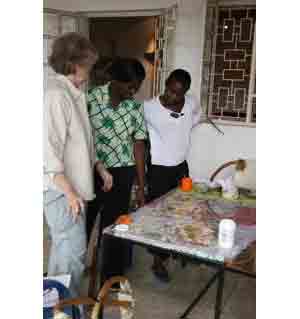
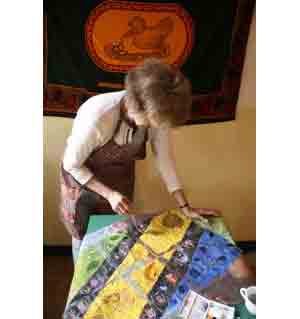 I
started early this morning to work on the Tanzania flag piece that I and
the workshop participants made during the workshop on Saturday. I wanted
to add some paint and collage elements and finish it in time for the opening
of my exhibition at the Arusha Masai Cafe Gallery this evening at 6:30
pm. We finished up the hanging of all my Taiwan site maps inside the gallery,
but I wanted to have one Tanzanian work finished for the opening. This
photo shows some of the staff at the cafe helping me find some photos
of people to put in the black stripes on the flag. They told me that this
stripe represents the people of Tanzania. I also learned that the yellow
stripe represents the sun, the blue the ocean, and the green one the land.
This photo shows me finishing the painting of the flag. It was even still
a little wet when the show opened that evening.
I
started early this morning to work on the Tanzania flag piece that I and
the workshop participants made during the workshop on Saturday. I wanted
to add some paint and collage elements and finish it in time for the opening
of my exhibition at the Arusha Masai Cafe Gallery this evening at 6:30
pm. We finished up the hanging of all my Taiwan site maps inside the gallery,
but I wanted to have one Tanzanian work finished for the opening. This
photo shows some of the staff at the cafe helping me find some photos
of people to put in the black stripes on the flag. They told me that this
stripe represents the people of Tanzania. I also learned that the yellow
stripe represents the sun, the blue the ocean, and the green one the land.
This photo shows me finishing the painting of the flag. It was even still
a little wet when the show opened that evening.
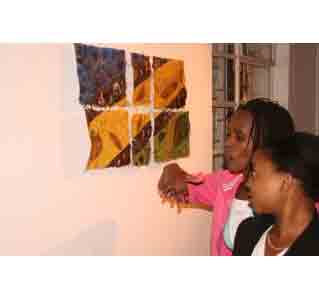
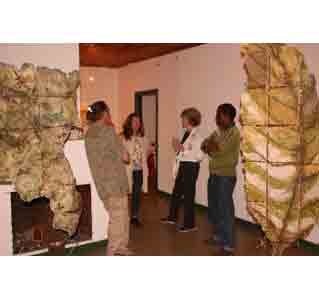 The opening reception for my exhibition was very nice and the gallery looked beautiful. This photo shows some visitors looking at my Tanzania flag piece at the opening reception. The other photo is a view of the gallery at the opening reception.
The opening reception for my exhibition was very nice and the gallery looked beautiful. This photo shows some visitors looking at my Tanzania flag piece at the opening reception. The other photo is a view of the gallery at the opening reception.
Friday, February 8, 2008
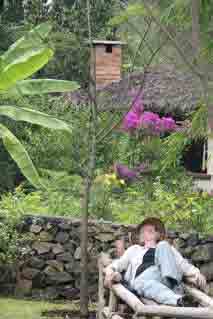
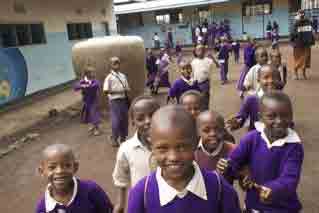 Today
Tim, Seppo and I went to Motivation Lodge and school just outside of Arusha.
Seppo arranged for Tim to take some photographs for the lodge company
in exchange for allowing us to stay for free at their lodges in the national
parks we will be visiting next week on our safari. It is a chance for
Tim to do some interesting professional photography with the new camera
he purchased before we came here to Africa. This photo shows me acting
as a model for one of the shots Tim took out by the pool. After taking
photos at the lodge we took a walk with some of the staff to a nearby
school that is partly supported by the lodge company. This visit to a
school was quite interesting and we were amazed at so many students all
in their bright purple uniforms. This photo shows many of the students
greeting us in the school courtyard.
Today
Tim, Seppo and I went to Motivation Lodge and school just outside of Arusha.
Seppo arranged for Tim to take some photographs for the lodge company
in exchange for allowing us to stay for free at their lodges in the national
parks we will be visiting next week on our safari. It is a chance for
Tim to do some interesting professional photography with the new camera
he purchased before we came here to Africa. This photo shows me acting
as a model for one of the shots Tim took out by the pool. After taking
photos at the lodge we took a walk with some of the staff to a nearby
school that is partly supported by the lodge company. This visit to a
school was quite interesting and we were amazed at so many students all
in their bright purple uniforms. This photo shows many of the students
greeting us in the school courtyard.
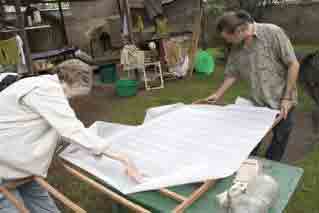
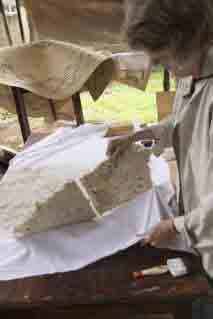 We came back to WHAT studio at lunch time, and Seppo found that the local woodworker had delivered the new large screen for papermaking that he had ordered. This screen has supports about every 6 inches and should really work well to make large sheets of paper with even thickness. This photo shows us trying to figure out what type of screening will be best to use for the large paper screen. In Tanzania it is difficult to find screening that does not rust but we did find some white plastic coated screening and we think maybe it will work well with some cotton over the top to make a smoother surface. The Tanzania map piece was finally dry too, so this photo shows me taking it off the screen. Later I will paint and do some collage on this piece to finish it.
We came back to WHAT studio at lunch time, and Seppo found that the local woodworker had delivered the new large screen for papermaking that he had ordered. This screen has supports about every 6 inches and should really work well to make large sheets of paper with even thickness. This photo shows us trying to figure out what type of screening will be best to use for the large paper screen. In Tanzania it is difficult to find screening that does not rust but we did find some white plastic coated screening and we think maybe it will work well with some cotton over the top to make a smoother surface. The Tanzania map piece was finally dry too, so this photo shows me taking it off the screen. Later I will paint and do some collage on this piece to finish it.
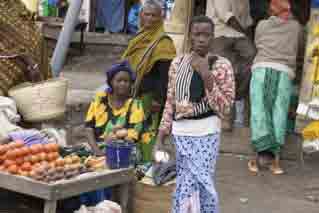
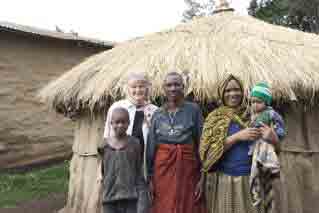 Late that afternoon we went with Seppo and his wife Julieth to take her father to the small village they are from that is north of Arusha on the road to Nairobi, Kenya. We drove on a paved highway that was very narrow and full of potholes for about 45 minutes. This road is full of traffic and many interesting things to see along the roadside. We came to the village and this photo shows some of the village vegetable sellers. We drove up into the hills outside the small village to some property owned by Julieth's father. There we met a local family and took some photographs with them. This photo shows me posing with two Masai women and their children. The Masai women seemed amazed and so happy to see their faces in Tim's camera when we reviewed the photos for them. We think maybe they have never seen their own faces in a photo. We hope to print out some of the photos Tim took and take back to them as gifts.
Late that afternoon we went with Seppo and his wife Julieth to take her father to the small village they are from that is north of Arusha on the road to Nairobi, Kenya. We drove on a paved highway that was very narrow and full of potholes for about 45 minutes. This road is full of traffic and many interesting things to see along the roadside. We came to the village and this photo shows some of the village vegetable sellers. We drove up into the hills outside the small village to some property owned by Julieth's father. There we met a local family and took some photographs with them. This photo shows me posing with two Masai women and their children. The Masai women seemed amazed and so happy to see their faces in Tim's camera when we reviewed the photos for them. We think maybe they have never seen their own faces in a photo. We hope to print out some of the photos Tim took and take back to them as gifts.
Saturday, February 9, 2008
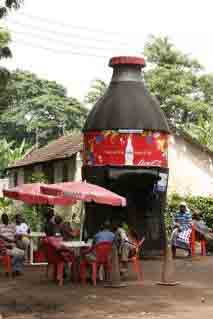
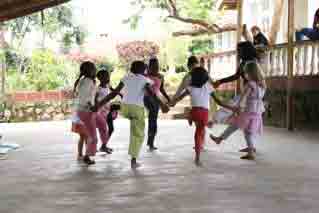 This morning we took a walk to visit Umoja Arts School in Arusha. As we walked down the road from the Arusha Mosaie Cafe and WHAT studio where we are staying, we passed by the coke bottle cafe that you can see in this photo. Umoja school is a private art school supported by some foundations and businesses in the community and the foreign residents. They have classes in violin, guitar, dance, and visual arts. Most of the classes take place on Saturday, and it was wonderful to visit the school and see the dance class and have a chance to observe the drawing class. The art teacher Linda is originally from Canada, and she is also the art teacher at the International School in Arusha.
This morning we took a walk to visit Umoja Arts School in Arusha. As we walked down the road from the Arusha Mosaie Cafe and WHAT studio where we are staying, we passed by the coke bottle cafe that you can see in this photo. Umoja school is a private art school supported by some foundations and businesses in the community and the foreign residents. They have classes in violin, guitar, dance, and visual arts. Most of the classes take place on Saturday, and it was wonderful to visit the school and see the dance class and have a chance to observe the drawing class. The art teacher Linda is originally from Canada, and she is also the art teacher at the International School in Arusha.
Linda was teaching the students about contour drawing, and I also was asked to show them a few things about drawing. 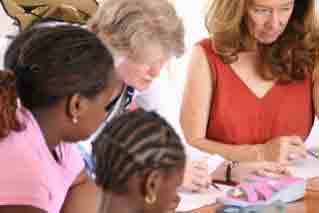
This photo shows me sharing some drawing techniques with the students.
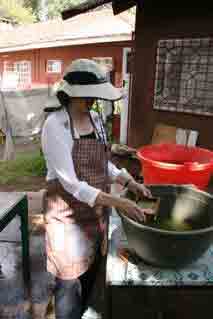 After coming back to WHAT I made some paper with the mulberry bark pulp we had prepared from the branches gathered at Michael's place two days before. This pulp is quite green in color and it may be because the mulberry trees there got much more water. The paper may retain the green color too. Here is a photo of me forming some samples with the green mulberry bark.
After coming back to WHAT I made some paper with the mulberry bark pulp we had prepared from the branches gathered at Michael's place two days before. This pulp is quite green in color and it may be because the mulberry trees there got much more water. The paper may retain the green color too. Here is a photo of me forming some samples with the green mulberry bark.
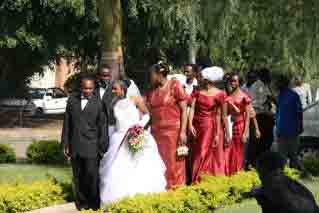 Later that afternoon Tim and I took a long walk over to the large traffic circle in Arusha where all the wedding parties come to take photos and dance and sing. We got to this traffic circle about 3 PM and had to wait a while for a wedding party to arrive. The traffic circle has a park area in the center with a fountain, trees and grass. We waited there on a bench and soon a wedding party arrived. This photo shows the beautiful bride, groom and bridesmaids and family arriving at the traffic circle park. It seems to be a unique Arusha custom to go to this traffic circle after the wedding for some photos and singing and dancing. Usually there is a live band too but this particular wedding did not have a band. After taking some photos we walked back into town and did a little shopping and had a milk shake at the local cafe at a local cafe. After this we returned to WHAT studio.
Later that afternoon Tim and I took a long walk over to the large traffic circle in Arusha where all the wedding parties come to take photos and dance and sing. We got to this traffic circle about 3 PM and had to wait a while for a wedding party to arrive. The traffic circle has a park area in the center with a fountain, trees and grass. We waited there on a bench and soon a wedding party arrived. This photo shows the beautiful bride, groom and bridesmaids and family arriving at the traffic circle park. It seems to be a unique Arusha custom to go to this traffic circle after the wedding for some photos and singing and dancing. Usually there is a live band too but this particular wedding did not have a band. After taking some photos we walked back into town and did a little shopping and had a milk shake at the local cafe at a local cafe. After this we returned to WHAT studio.
Monday, February 11 - Friday, February 15, 2008
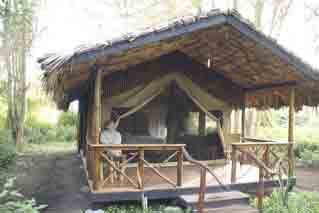
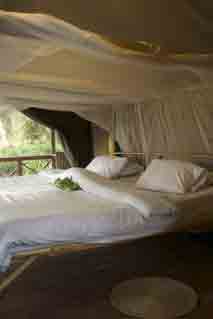 During these five days Tim and I went on a safari to some of the most important national parks and conservation areas in Tanzania. We had our own guide and driver named Julius who was an excellent driver and also very knowledgeable about the land, animals, birds and plants of Tanzania. Julius drove us in his safari vehicle, a Land Cruiser with open top so that you can stand up to photograph things and see better. During our safari we stayed overnights at tented lodges. Seppo had arranged for Tim to take some photographs of the places where we stayed for the management to use on their websites and promotional brochures. In exchange for the photographing, we had free stays at the tented lodges. These lodges are in very scenic areas and cheaper than regular hotels inside or near the parks. The tented lodges have individual tents with a real bed, floor and roof and your own bathroom.
During these five days Tim and I went on a safari to some of the most important national parks and conservation areas in Tanzania. We had our own guide and driver named Julius who was an excellent driver and also very knowledgeable about the land, animals, birds and plants of Tanzania. Julius drove us in his safari vehicle, a Land Cruiser with open top so that you can stand up to photograph things and see better. During our safari we stayed overnights at tented lodges. Seppo had arranged for Tim to take some photographs of the places where we stayed for the management to use on their websites and promotional brochures. In exchange for the photographing, we had free stays at the tented lodges. These lodges are in very scenic areas and cheaper than regular hotels inside or near the parks. The tented lodges have individual tents with a real bed, floor and roof and your own bathroom.
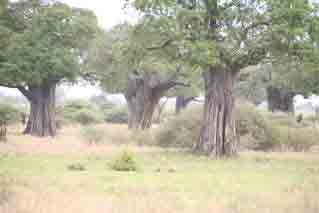
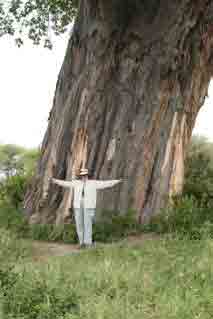 We first visited Tarangire National Park, known for its baobob trees that have very large trunks and look somewhat like upside down trees. Since we are in the wet season now, we did not see so many animals in this park. The second day we got up early to go to the Ngorongoro Conservation area. This area is a crater that is the largest completely enclosed caldera in the world and home to many different animals and birds. It seemed almost like a zoo with so many animals in a relatively small area. There is a lake in the bottom of the crater and it was filled with many water birds including flamingos. This day was filled with lots of driving over very rough roads to go up to the crater rim and then descend inside. We stopped many times to take photos and look closely at the animals and birds with binoculars. We could not leave the car in this park except at designated stops.
We first visited Tarangire National Park, known for its baobob trees that have very large trunks and look somewhat like upside down trees. Since we are in the wet season now, we did not see so many animals in this park. The second day we got up early to go to the Ngorongoro Conservation area. This area is a crater that is the largest completely enclosed caldera in the world and home to many different animals and birds. It seemed almost like a zoo with so many animals in a relatively small area. There is a lake in the bottom of the crater and it was filled with many water birds including flamingos. This day was filled with lots of driving over very rough roads to go up to the crater rim and then descend inside. We stopped many times to take photos and look closely at the animals and birds with binoculars. We could not leave the car in this park except at designated stops.
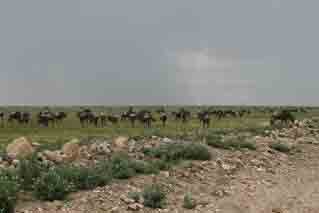
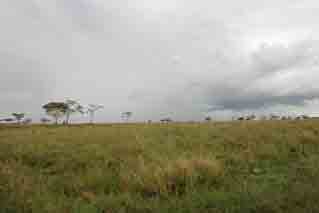 After
a picnic lunch at one of the rest stops in the crater we were on the road
again through Seringeti National Park. It was an amazing site to
be on such a vast open plain that looked like an ocean of grass.
The road was unpaved and dusty but we passed through several rain showers.
The going was slow so it took about 4 hours to reach our tented
lodge camp on the western side of the Serengeti. We encountered
some of the thousands of migrating wildebeests who are accompanied by
zebra and gazelles and other grazing animals and also the predators like
lions.
After
a picnic lunch at one of the rest stops in the crater we were on the road
again through Seringeti National Park. It was an amazing site to
be on such a vast open plain that looked like an ocean of grass.
The road was unpaved and dusty but we passed through several rain showers.
The going was slow so it took about 4 hours to reach our tented
lodge camp on the western side of the Serengeti. We encountered
some of the thousands of migrating wildebeests who are accompanied by
zebra and gazelles and other grazing animals and also the predators like
lions.
It 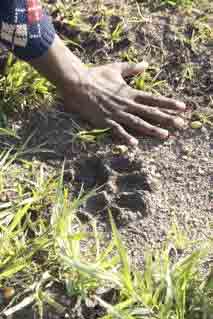 was an amazing site to see so many animals on the move, and a whole group passed right in front
was an amazing site to see so many animals on the move, and a whole group passed right in front 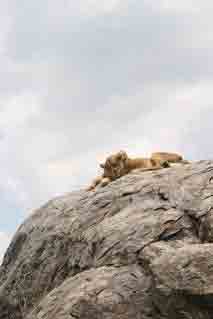 of our vehicle. We saw many giraffes, elephants, lions, cheetahs and other animals, and stayed for two days of game watching in this park. The tented lodge where we stayed was just outside of Seringeti Park and in the bush. During our stay at this lodge, we also went on a morning walk in the bush conducted by a guide from the lodge. This was a great experience to be able to have a closer look at some of the plants and smaller animals of the bush. We also took a guided night game drive that the lodge offered. It was very interesting to see the animals that are active at night and get a different look at the landscape. The guide had a large spotlight to pick out the animals, and the driver went off the road into the bush to get closer looks at some of the animals at night.
of our vehicle. We saw many giraffes, elephants, lions, cheetahs and other animals, and stayed for two days of game watching in this park. The tented lodge where we stayed was just outside of Seringeti Park and in the bush. During our stay at this lodge, we also went on a morning walk in the bush conducted by a guide from the lodge. This was a great experience to be able to have a closer look at some of the plants and smaller animals of the bush. We also took a guided night game drive that the lodge offered. It was very interesting to see the animals that are active at night and get a different look at the landscape. The guide had a large spotlight to pick out the animals, and the driver went off the road into the bush to get closer looks at some of the animals at night.
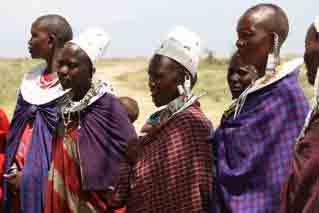
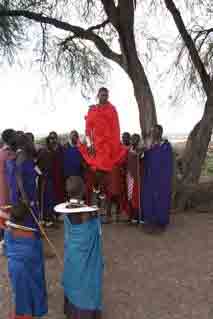 On the way back across the Serengeti we stopped at a traditional Masai village and had a tour. The tour is geared for the tourists but does give you a glimpse into the life of this tribe and includes a welcome dance with singing and lots of jumping by the men. We also got to go inside a traditional house and were told about the lifestyle and customs of the Masai. We learned that it takes 10 cows as a dowry to get a wife, and the Masai men can have many wives if they have enough cows. We bought some souvenir jewelry, and Tim got a traditional Masai walking stick.
On the way back across the Serengeti we stopped at a traditional Masai village and had a tour. The tour is geared for the tourists but does give you a glimpse into the life of this tribe and includes a welcome dance with singing and lots of jumping by the men. We also got to go inside a traditional house and were told about the lifestyle and customs of the Masai. We learned that it takes 10 cows as a dowry to get a wife, and the Masai men can have many wives if they have enough cows. We bought some souvenir jewelry, and Tim got a traditional Masai walking stick.
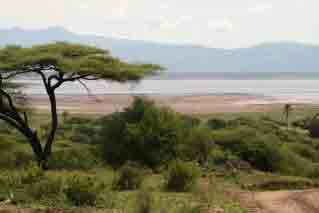
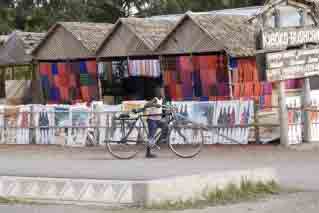 We passed through many different villages on our way back to the tented lodge just outside of Lake Manyara National Park where we stayed again for the 5 th and final day of our safari. This tented lodge is in a grove of beautiful yellow-bark acacia trees. The next day we did a game drive in Lake Manyara National Park and also did a walking tour of a local village. Lake Manyara National Park is full of many birds and lots of elephants. It has many different eco regions including a rain forest, plain and lake. On the way back to Arusha we again passed through many villages and saw colorful markets, interesting people and also lots of animals along the way. Our safari was a once in a lifetime experience and a wonderful way to get to know more about the land, people and animals of Tanzania.
We passed through many different villages on our way back to the tented lodge just outside of Lake Manyara National Park where we stayed again for the 5 th and final day of our safari. This tented lodge is in a grove of beautiful yellow-bark acacia trees. The next day we did a game drive in Lake Manyara National Park and also did a walking tour of a local village. Lake Manyara National Park is full of many birds and lots of elephants. It has many different eco regions including a rain forest, plain and lake. On the way back to Arusha we again passed through many villages and saw colorful markets, interesting people and also lots of animals along the way. Our safari was a once in a lifetime experience and a wonderful way to get to know more about the land, people and animals of Tanzania.
Here are some additional photos of our safari.
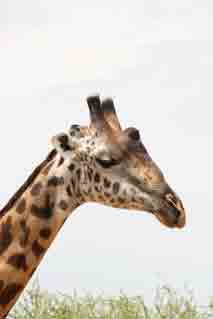
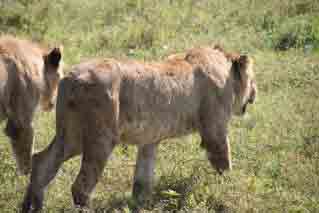
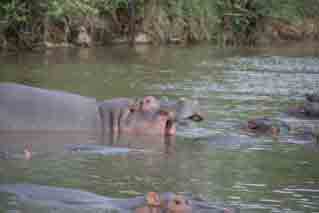
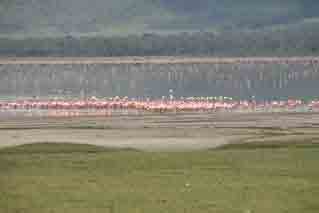
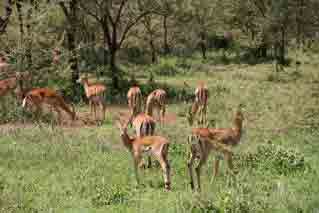
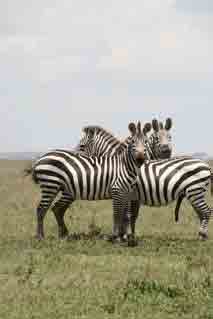
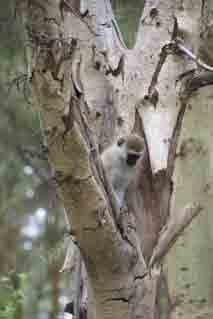
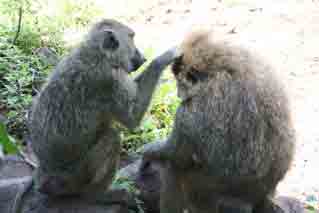
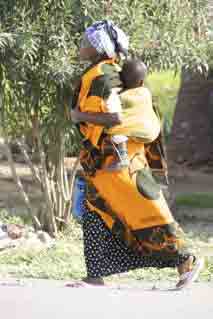
Saturday, February 16, 2008
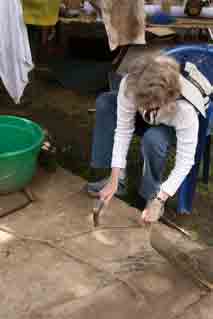
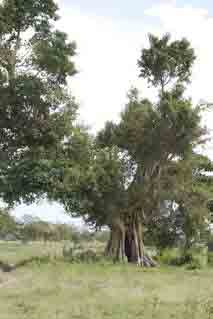 This
was our first full day after the safari. In the morning we washed all
of our clothes that were very dirty from the trip. I had gathered a few
branches from a large tree that we saw on our visit to the village near
Lake Manyara. I thought this tree looked a little like a baobob tree,
but our guide told me it was similar but not a baobob. I thought that
the bark might make interesting paper. I stripped the bark from the few
branches that we brought back. I found it came off easily and seemed very
strong. This photo shows me taking the bark off the branches. I plan to
cook this small bit tomorrow and make some samples from it to see what
kind of paper it will make.
This
was our first full day after the safari. In the morning we washed all
of our clothes that were very dirty from the trip. I had gathered a few
branches from a large tree that we saw on our visit to the village near
Lake Manyara. I thought this tree looked a little like a baobob tree,
but our guide told me it was similar but not a baobob. I thought that
the bark might make interesting paper. I stripped the bark from the few
branches that we brought back. I found it came off easily and seemed very
strong. This photo shows me taking the bark off the branches. I plan to
cook this small bit tomorrow and make some samples from it to see what
kind of paper it will make.
After lunch I was in the gallery area working on painting the other side of my Tanzanian flag piece, and met a young woman who came to visit her sister here at the Arusha Masai Cafe. This young woman was very interested in my papermaking experiments with different plants of Tanzania, and I learned that she majored in forestry. I asked for her help to identify the tree that I thought was related to baobob. She told me it was Cordia ovadis, and I remembered that I had also used a Cordia species for paper in Taiwan. This is a photo that Tim took of the tree.
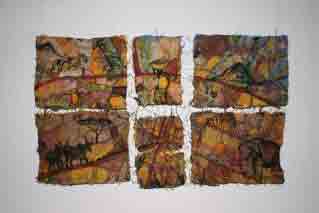 During the afternoon I completed the painting on the back side of the flag piece. I made this side as a map of the city of Arusha and included the rivers and major roads. I also included some animals and people and used mainly yellow, red and brown and black colors with some green because these are the colors of Africa to me. This photo shows the finished piece.
During the afternoon I completed the painting on the back side of the flag piece. I made this side as a map of the city of Arusha and included the rivers and major roads. I also included some animals and people and used mainly yellow, red and brown and black colors with some green because these are the colors of Africa to me. This photo shows the finished piece.
Sunday, February 17, 2008
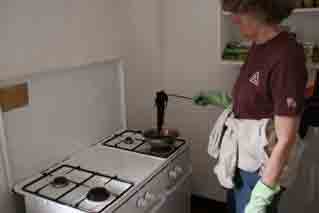
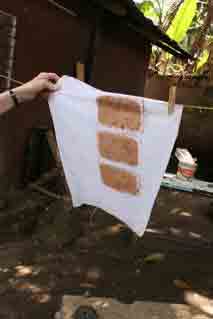 Sundays here are a day of rest usually with no stores open. Since the Arusha Masai Cafe is also closed on Sundays, I decided to try cooking the small amount of Cordia fibers I had gathered on the safari by using one of the gas stoves in the kitchen. I thought maybe it would be faster and easier than the usual cooking we had been doing on the wood fire outdoors. Also, on Sunday there would be no customers to complain about the bad smell from the cooking bark! This photo shows me stirring the cooking pot in the cafe's kitchen.This bark cooked quickly in about one hour, and I washed and beat the fiber by hand . There was only a small amount of fiber but I did make some sample sheets as you can see in this photo. This tree Cordia ovatis seems to be very good for papermaking and the color is a rich brown.
Sundays here are a day of rest usually with no stores open. Since the Arusha Masai Cafe is also closed on Sundays, I decided to try cooking the small amount of Cordia fibers I had gathered on the safari by using one of the gas stoves in the kitchen. I thought maybe it would be faster and easier than the usual cooking we had been doing on the wood fire outdoors. Also, on Sunday there would be no customers to complain about the bad smell from the cooking bark! This photo shows me stirring the cooking pot in the cafe's kitchen.This bark cooked quickly in about one hour, and I washed and beat the fiber by hand . There was only a small amount of fiber but I did make some sample sheets as you can see in this photo. This tree Cordia ovatis seems to be very good for papermaking and the color is a rich brown.
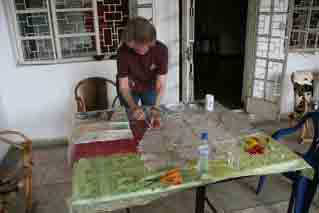
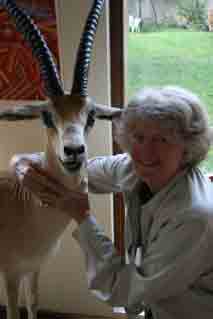 Later I worked on the Tanzania site map and started to glue down some leaves and flower petals on one side. In Tanzania I was not able to find acrylic matte gel that I usually use for glue, so I used a white wood glue that works okay but does make things a bit shiny. It is always challenging adapting to whatever is available in each place. This photo shows me beginning the gluing on the Tanzania site map.
Later I worked on the Tanzania site map and started to glue down some leaves and flower petals on one side. In Tanzania I was not able to find acrylic matte gel that I usually use for glue, so I used a white wood glue that works okay but does make things a bit shiny. It is always challenging adapting to whatever is available in each place. This photo shows me beginning the gluing on the Tanzania site map.
In the evening Seppo and his wife and son took us to dinner in nearby Moshi at a restaurant and lodge managed by Julieth brother. We enjoyed seeing the lodge restaurant that is for the safari visitors and it has many stuffed animals about for decoration. I got a little silly and posed for this photo hugging a stuffed antelope. Tim says it looks like I might be choking the animal!
Monday, February 18, 2008
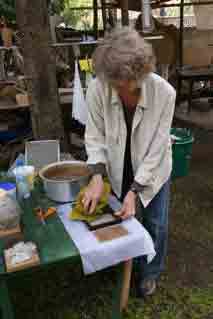
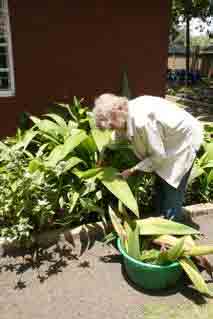 Today
I worked more on the Tanzania Site Map and began painting in some lakes
and roads and mountains for this piece. This photo shows the work in progress.
Later in the morning I also finished beating the bark fibers from what
I thought was the Hong Kong Orchid Tree that we had cooked on Sunday.
This photo shows me making the samples. This bark fiber was not good for
papermaking and seemed to have almost no pulping qualities. I believe
it must be a different species from the tree that I had tried in Taiwan.
I also picked some large long bladed leaves growing in the garden at Arusha
Masai Cafe. I believe this leaf is from a species of lily as I noticed
it has a white lily like flower. The leaves seem like they may have some
good fiber for papermaking. This photo shows me gathering the leaves.
We plan to cook them on the outdoor fire and then make samples tomorrow.
Today
I worked more on the Tanzania Site Map and began painting in some lakes
and roads and mountains for this piece. This photo shows the work in progress.
Later in the morning I also finished beating the bark fibers from what
I thought was the Hong Kong Orchid Tree that we had cooked on Sunday.
This photo shows me making the samples. This bark fiber was not good for
papermaking and seemed to have almost no pulping qualities. I believe
it must be a different species from the tree that I had tried in Taiwan.
I also picked some large long bladed leaves growing in the garden at Arusha
Masai Cafe. I believe this leaf is from a species of lily as I noticed
it has a white lily like flower. The leaves seem like they may have some
good fiber for papermaking. This photo shows me gathering the leaves.
We plan to cook them on the outdoor fire and then make samples tomorrow.
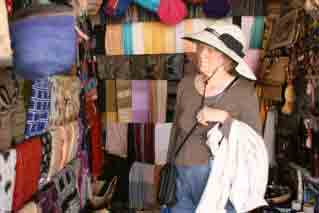 During
the afternoon Tim and I walked into Arusha town to do some souvenir shopping.
Again we went to the Masai Market. This photo shows me looking at fabric
in one of the shops. This place is crammed with stuff and most of it looks
all the same and as Westerners you are constantly being harassed by vendors
wanting you to come to their shop and buy something. It is also a place
that requires hard bargaining and prices for Westerners are always much
higher than they should be. Nevertheless it is a very interesting place
and we did buy some things to take back with us.
During
the afternoon Tim and I walked into Arusha town to do some souvenir shopping.
Again we went to the Masai Market. This photo shows me looking at fabric
in one of the shops. This place is crammed with stuff and most of it looks
all the same and as Westerners you are constantly being harassed by vendors
wanting you to come to their shop and buy something. It is also a place
that requires hard bargaining and prices for Westerners are always much
higher than they should be. Nevertheless it is a very interesting place
and we did buy some things to take back with us.
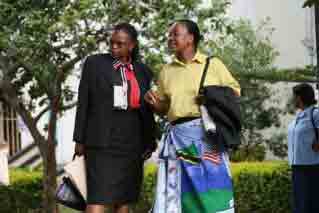 On the way home we stopped to rest on one corner opposite the Arusha city government offices. We were watching people passing by and noticed one woman wearing a very interesting Conga - that is the traditional wrapped skirt that all the women wear here. Her Conga had the US flag and the Tanzania flag on the front as you can see in this photo. On the back was a large photo of President Bush and the President of Tanzania. This reminded us that today Bush was visiting in Arusha. The main road from Arusha to Moshi and the airport was closed all day from 8AM to 5PM for this visit!
On the way home we stopped to rest on one corner opposite the Arusha city government offices. We were watching people passing by and noticed one woman wearing a very interesting Conga - that is the traditional wrapped skirt that all the women wear here. Her Conga had the US flag and the Tanzania flag on the front as you can see in this photo. On the back was a large photo of President Bush and the President of Tanzania. This reminded us that today Bush was visiting in Arusha. The main road from Arusha to Moshi and the airport was closed all day from 8AM to 5PM for this visit!
Tuesday, February 19
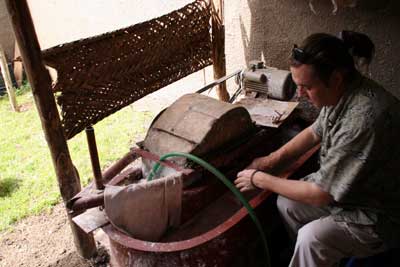
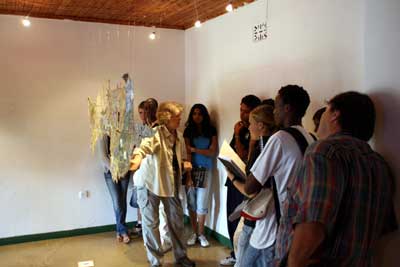 Today
we had a school group visiting WHAT studios to see my exhibition and learn
about hand papermaking. Seppo prepared some cotton pulp in his Hollander
beater that he has put together. This photo shows Seppo putting some cotton
fabric strips into the beating machine. We also used some of the banana
leaf pulp that we had cooked and prepared with hand beating for the students.
The students arrived about 10:30 AM and planned to stay through lunch
and enjoy some pizza and pasta from the Arusha Masai Cafe on this field
trip. The students were 9th graders and in the art class at the Arusha
International School. In this photo you can see me explaining my artwork
in the gallery to the students. They had many good questions and seemed
very interested in the handmade paper art.
Today
we had a school group visiting WHAT studios to see my exhibition and learn
about hand papermaking. Seppo prepared some cotton pulp in his Hollander
beater that he has put together. This photo shows Seppo putting some cotton
fabric strips into the beating machine. We also used some of the banana
leaf pulp that we had cooked and prepared with hand beating for the students.
The students arrived about 10:30 AM and planned to stay through lunch
and enjoy some pizza and pasta from the Arusha Masai Cafe on this field
trip. The students were 9th graders and in the art class at the Arusha
International School. In this photo you can see me explaining my artwork
in the gallery to the students. They had many good questions and seemed
very interested in the handmade paper art.
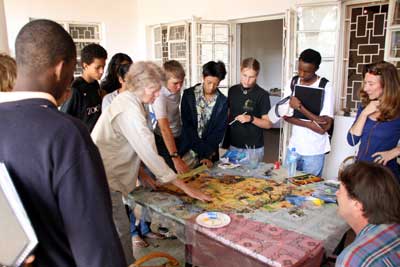
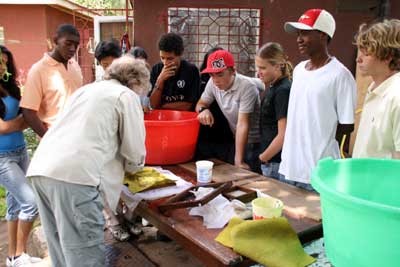
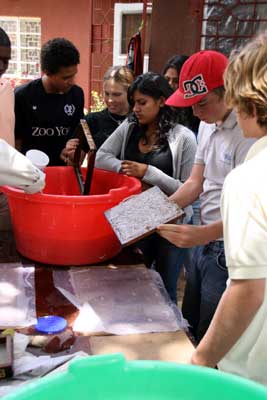 After
the gallery tour, I showed them my Tanzania site map that I was working
on. I wanted to complete the other side of this piece before I left Tanzania.
This photo shows me talking to the students and showing them my work in
progress. Then the students went out to the papermaking studio area, and
I taught them how to make paper using the banana fiber and some of the
cotton fibers. These photos show me teaching the students about papermaking
and the students making their first sheets of handmade paper.
After
the gallery tour, I showed them my Tanzania site map that I was working
on. I wanted to complete the other side of this piece before I left Tanzania.
This photo shows me talking to the students and showing them my work in
progress. Then the students went out to the papermaking studio area, and
I taught them how to make paper using the banana fiber and some of the
cotton fibers. These photos show me teaching the students about papermaking
and the students making their first sheets of handmade paper.
The rest of the day was spent packing and getting things dry for packing. We also had to do some last-minute souvenir shopping at the local T-shirt shop and the Masai Market in Arusha.
Wednesday, February 20
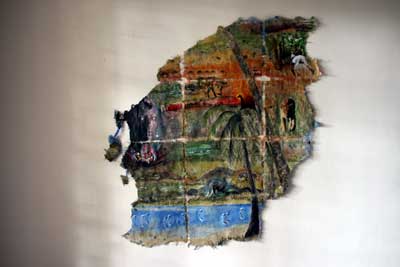
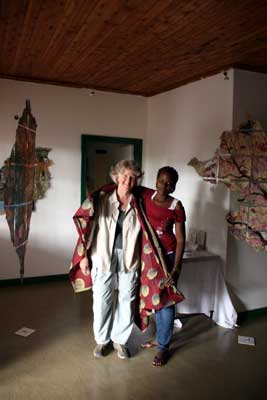 In
the early morning I finished up the Tanzania site map, and this photo
shows the finished piece. I plan to take the two pieces I made during
the residency with me to exhibit in Taiwan and the US A.. We finished
all our packing so we could leave for the airport. One surprise that morning
was that Julieth, Seppo's wife, gave me a piece of fabric that is used
by the Tanzanian women as skirt and blouse. This Konga cloth is really
special, and I love the colors and pattern that she selected for me. This
photo shows her wrapping the Konga cloth around me to show me a little
about how this cloth should be worn.
In
the early morning I finished up the Tanzania site map, and this photo
shows the finished piece. I plan to take the two pieces I made during
the residency with me to exhibit in Taiwan and the US A.. We finished
all our packing so we could leave for the airport. One surprise that morning
was that Julieth, Seppo's wife, gave me a piece of fabric that is used
by the Tanzanian women as skirt and blouse. This Konga cloth is really
special, and I love the colors and pattern that she selected for me. This
photo shows her wrapping the Konga cloth around me to show me a little
about how this cloth should be worn.
Our
flight back to Taiwan was at 2:45 PM from Kilimanjaro International Airport.
Since the airport is between Arusha and Moshi, we decided to leave in
the morning and go to Moshi first. We wanted to visit 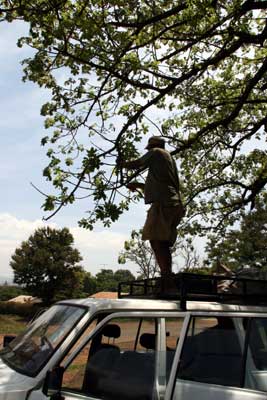 Samwell
and the tree farm again to see how he was doing with his papermaking using
local plants. He took the workshop I taught at WHAT and seemed most enthusiastic
about the papermaking. He is also an excellent source of information about
the local plants. I feel that Samwell will definitely carry on with the
papermaking from local plants. Seppo also needed to pick up some more
materials for papermaking in Moshi, and he especially wanted to get some
more mulberry tree bark from Samwell. We both agree that the African mulberry
is a very good papermaking fiber, and Seppo plans to continue using it.
Samwell is now growing it for papermaking! While we were in Moshi Samwell
also took us to find a baobob tree so we could gather some bark to try
it for papermaking.
Samwell
and the tree farm again to see how he was doing with his papermaking using
local plants. He took the workshop I taught at WHAT and seemed most enthusiastic
about the papermaking. He is also an excellent source of information about
the local plants. I feel that Samwell will definitely carry on with the
papermaking from local plants. Seppo also needed to pick up some more
materials for papermaking in Moshi, and he especially wanted to get some
more mulberry tree bark from Samwell. We both agree that the African mulberry
is a very good papermaking fiber, and Seppo plans to continue using it.
Samwell is now growing it for papermaking! While we were in Moshi Samwell
also took us to find a baobob tree so we could gather some bark to try
it for papermaking. 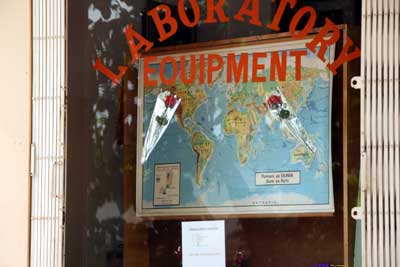 Since
this is such an interesting unique tree associated with Africa, I thought
it would be one that we should definitely try for papermaking. This photo
shows Samwell gathering some baobob bark by climbing on top of Seppo's
vehicle. We also went to try and buy some more soda ash at a scientific
supply store where Seppo had purchased this material before. They did
not have any more soda ash but would order it for him. While in the store
we noticed a map of the world on display that had Africa in the center
of the world. This photo shows the map.
Since
this is such an interesting unique tree associated with Africa, I thought
it would be one that we should definitely try for papermaking. This photo
shows Samwell gathering some baobob bark by climbing on top of Seppo's
vehicle. We also went to try and buy some more soda ash at a scientific
supply store where Seppo had purchased this material before. They did
not have any more soda ash but would order it for him. While in the store
we noticed a map of the world on display that had Africa in the center
of the world. This photo shows the map.
We ate lunch in Moshi at an Indian restaurant and then headed for the airport to catch our flight. We flew the same route back taking Ethiopian Airlines from Kilimanjaro to Nairobi, Kenya, staying on the same plane and continuing to Addis Ababa, Ethiopia. There we changed planes and continued with Ethiopian Airlines to Bangkok, Thailand. In Bangkok the plane developed some mechanical problems, and we sat on the runway for hours while they tried to repair it to continue the flight to Hong Kong. Finally they decided the plane could not be fixed and that they would have to re-schedule everyone on other flights. We ended up staying the night in a Bangkok hotel courtesy of the airlines and then took a Thai Airlines flight the next morning directly to Taipei. There we learned that our baggage was lost somewhere, and we signed forms to have the baggage delivered to our place in Taichung once it was found. We took a bus from Taipei international airport to our home in Taichung for another two hours of traveling. It was a long and grueling trip but we were happy to be home in Taiwan. Our lost baggage arrived the next day so all was well.
The residency in Tanzania, Africa, was a great experience, and it will take me a while to reflect on everything. I hope one day to return to this continent for more opportunities as an artist.
(updated on February 27, 2008 )
For more information about Jane and her artwork and other projects, click on one of the icons below







